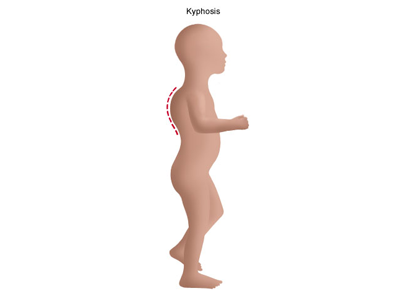What is kyphosis?
 A normal spine, when viewed from behind, appears straight. However, a spine affected by kyphosis shows evidence of a forward curvature of the back bones (vertebrae) in the upper back area, giving an abnormally rounded or "humpback" appearance.
A normal spine, when viewed from behind, appears straight. However, a spine affected by kyphosis shows evidence of a forward curvature of the back bones (vertebrae) in the upper back area, giving an abnormally rounded or "humpback" appearance.
Kyphosis is defined as a curvature of the spine measuring 50 degrees or greater on an X-ray (a diagnostic test that uses invisible electromagnetic energy beams to produce images of internal tissues, bones, and organs onto film). The normal spine can bend from 20 to 45 degrees of curvature in the upper back area. Kyphosis is a type of spinal deformity.
What causes kyphosis?
Kyphosis can be congenital (present at birth), or due to acquired conditions that may include the following:
-
Metabolic problems
-
Neuromuscular conditions
-
Osteogenesis imperfecta - also called "brittle bone disease." A condition that causes bones to fracture with minimal force.
-
Spina bifida
-
Scheuermann's disease - a condition that causes the vertebrae to curve forward in the upper back area. The cause of Scheuermann's disease is unknown and is commonly seen in males.
-
Postural kyphosis - the most common type of kyphosis. It generally becomes noticeable in adolescence and can be associated with slouching versus a spinal abnormality. Exercise is used to help correct posture.
Kyphosis is more common in females than males.
What are the symptoms of kyphosis?
The following are the most common symptoms of kyphosis. However, each individual may experience symptoms differently. Symptoms may include:
-
A difference in shoulder height
-
The head bends forward compared to the rest of the body
-
A difference in shoulder blade height or position
-
When bending forward, the height of the upper back appears higher than normal
-
Tight hamstrings (back thigh) muscles
Back pain, pain down the legs and changes in bowel and bladder habits are not commonly associated with kyphosis. A person experiencing these types of symptoms requires further medical evaluation by a physician.
The symptoms of kyphosis may resemble other spinal conditions or deformities or may be a result of an injury or infection. Always consult your physician for a diagnosis.
How is kyphosis diagnosed?
The physician makes the diagnosis of kyphosis with a complete medical history, physical examination, and diagnostic tests. If the patient is a child, the physician obtains a complete prenatal and birth history of him/her and asks if other family members are known to have kyphosis. The physician also will ask about developmental milestones, since some types of kyphosis can be associated with other neuromuscular disorders. Developmental delays may require further medical evaluation.
Diagnostic procedures may include the following:
-
X-rays - a diagnostic test that uses invisible electromagnetic energy beams to produce images of internal tissues, bones, and organs onto film. This test is used to measure and evaluate the curve. With the use of a full-spine x-ray, the physician or radiologist measures the angle of the spinal curve. A determination for treatment can often be made based on this measurement.
-
Radionuclide bone scan - a nuclear imaging technique that uses a very small amount of radioactive material injected into the patient's bloodstream to be detected by a scanner. This test shows blood flow to the bone and cell activity within the bone.
-
Magnetic resonance imaging (MRI)- is a diagnostic procedure that uses a combination of large magnets, radio frequencies, and a computer to produce detailed images of organs and structures within the body. This test is done to rule out any spinal cord and nerve abnormalities.
-
A computed tomography scan (Also called a CT or CAT scan.) - is a diagnostic imaging procedure that uses a combination of X-rays and computer technology to produce cross-sectional images (often called slices), both horizontally and vertically, of the body. A CT scan shows detailed images of any part of the body, including the bones, muscles, fat, and organs. CT scans are more detailed than general X-rays.
-
Blood tests
Early detection of kyphosis is important for successful treatment. Pediatricians, family physicians and even some school programs routinely look for signs of kyphosis.
Treatment of kyphosis:
Specific treatment for kyphosis will be determined by your physician based on:
-
Your age, overall health, and medical history
-
The extent of the condition
-
Your tolerance for specific medications, procedures, and therapies
-
Expectation for the course of the disease
-
Your opinion or preference
The goal of treatment is to stop the progression of the curve and prevent deformity. According to the Scoliosis Research Society, treatment may include:
-
Observation and repeated examinations
The child will need observation and repeated examinations. The progression of the curve depends upon the amount of skeletal growth or how skeletally mature the child is. Curve progression slows down or stops after the child reaches puberty.
-
Bracing
If the child is still growing, the physician may prescribe a brace. The type of brace and the amount of time spent in the brace will be determined by your physician.
-
Surgery
In rare instances, surgery is recommended when the curve measures 75 degrees or more on X-ray and bracing is not successful in slowing down the progression of the curve.